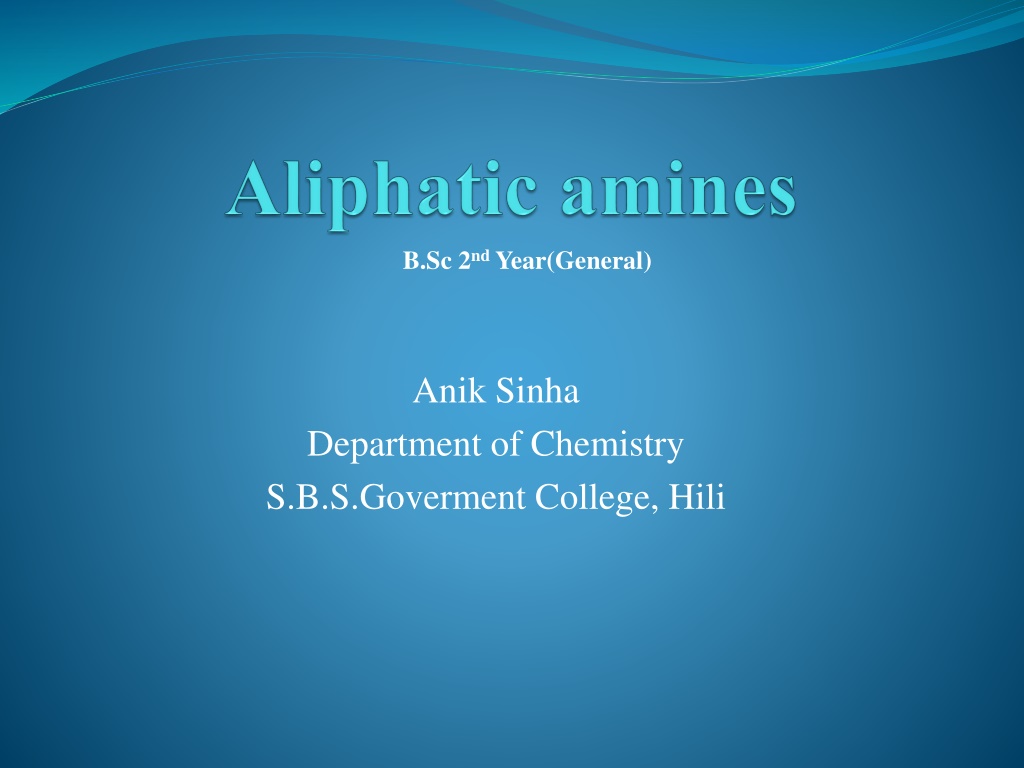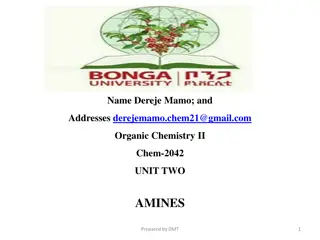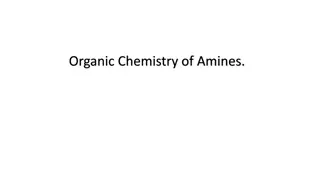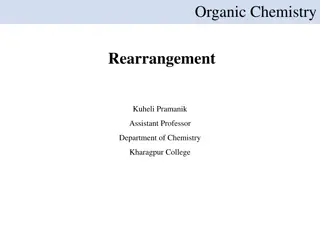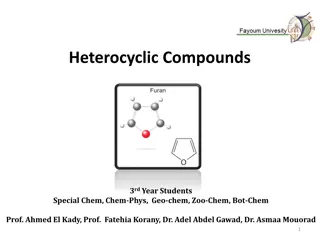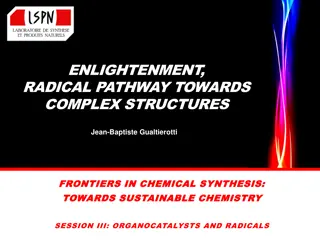Overview of Amines Synthesis and Reactions
This educational content delves into the classification and synthesis of amines, focusing on the synthesis of aliphatic amines through various methods like reduction of nitro compounds, acid amides, and aldoximes. It also discusses important reactions such as the Hofmann degradation, Curtius reaction, and Schmidt reaction, providing a comprehensive overview for students studying chemistry.
Download Presentation

Please find below an Image/Link to download the presentation.
The content on the website is provided AS IS for your information and personal use only. It may not be sold, licensed, or shared on other websites without obtaining consent from the author. Download presentation by click this link. If you encounter any issues during the download, it is possible that the publisher has removed the file from their server.
E N D
Presentation Transcript
B.Sc 2nd Year(General) Anik Sinha Department of Chemistry S.B.S.Goverment College, Hili
Overview Introduction Classifications of amines Synthesis of aliphatic amines Heinsberg s method of amine separation Grabriel Phthalimide Synthesis Distinction of 10, 20, 30 amines Basicity of amines Reference
Synthesis of aliphatic amines Synthesis of Primary amines: 1. Reduction of Nitro compounds: Sn/HCl R NH2 R NO2 R=Aliphatic group Or Zn/HCl Or Fe/HCl Or H2/Ni Aliphatic Nitro Compound Aliphatic Amine Or LiAlH4 2.Reduction of alkyl cyanide: R=Aliphatic group H2/Ni R-CN R-CH2-NH2 Or LiAlH4 Or Na/C2H5OH Cyanide Aliphatic Aliphatic Amine 3. Reduction Of acid amide: R=Aliphatic group Na/C2H5OH Or LiAlH4 RCONH2 RCH2NH2 Acid Amide Aliphatic Amine
4.Reduction of aldoxime or ketoxime: R H2 C Na+C2H5OH C N OH R NH2 LiAlH4 H Aldoxime Aliphatic Amine R=Aliphatic group R R Na+C2H5OH C N OH CH NH2 LiAlH4 R R Ketoxime Aliphatic Amine 5.Hofmann degradation: The Hofmann rearrangement is the organic reaction of a primary amide to a primary amine with one fewer carbon atom. Primary Amine Primary amide Isocyanate
Mechanism Aromatic amines also participates in Hofmann Degradation. 6.Curtius reaction: The Curtius rearrangement (or Curtius reaction or Curtius degradation), first defined by Theodo Curtius in 1885, is the thermal decomposition of an acyl azide to an isocyanate with loss of nitrogen gas. The isocyanate then undergoes attack by a variety of nucleophiles such as water, alcohols and amines, to yield a primary amine, carbamate or urea derivative respectively.
7.Schmidt reaction: The Schmidt reaction is an organic reaction in which an azide reacts with a carbonyl derivative, usually a aldehyde, ketone, or carboxylic acid, under acidic conditions to give an amine or amide, with expulsion of nitrogen. It is named after Karl Friedrich Schmidt (1887 1971), who first reported it in 1924 by successfully converting benzophenone Surprisingly, the intramolecular reaction was not reported until 1991 but has become important in the synthesis of natural products. and hydrazoic acid to benzanilide.
Reaction Scheme: Mechanism:
Synthesis Of Secondary amine 1. From alkyl isocyanides: H N H2/Ni R NC R CH3 Or Na/C2H5OH 2. From primary amines: C2H5NH2+C2H5I (C2H5)2NH+HI Synthesis Of tertiary amine 1. From quaternary ammonium Hydroxide: (CH3)4N+OH- (CH3)3N + CH3OH (CH3CH2)4N+OH- (CH3CH2)3N+ +H2O H2C CH2
Grabriel Phthalimide Synthesis The Gabriel synthesis is a chemical reaction that transforms primary alkyl halides into primary amines. Traditionally, the reaction uses potassium phthalimide. The reaction is named after the German chemist Siegmund Gabriel. Reaction Scheme Mechanism
Distinction of 10, 20, 30 amines 1. Heinsberg s Test: See previous Sections 2.Hofmann Mustard oil reaction:
Q. Methyl amine is more basic compare to aniline-Explain. Methyl amine is more base comparing with aniline, Because: In case of Aniline, the lone pair of Nitrogen atom participates in the delocalization with benzene ring. Thus the electron density in Nitrogen becomes less. That's why Nitrogen does not donate it electron pair to proton and aniline act as a less base. But in case of methyl amine(CH3NH2) the resonance is not possible and the -CH3 group has a +I effect, which increase the electron dentistry in Nitrogen. As a result Nitrogen donate it electron pair to proton..That's why Methyl amine react as a strong base compare to aniline. CH3 NH2 +I Effect of -CH3
Q. Compare the basicity of primary, secondary and tertiary amines. In Gas Phase:
In aqueous phase: (a)Inductive effect: As the number of alkyl group attaching to nitrogen atom increases the electron density on the nitrogen atom increases so the basicity increases from primary to tertiary. So, considering inductive effect the order should be (CH3)3N> (CH3)2NH > CH3NH2> NH3 (b) Solvation of Ions: When amines are dissolved in water, they form protonated amines. As we move from tertiary to primary number of H-bonding of protonated amines increases and also hydration energy increases. The more the hydration energy of the molecule, more is the stability of the amine. RNH2+H2O RNH3 R2NH +H2O R2NH2++ OH- (2 H-Bond) R3N + H2O R2NH++ OH- (1-H bond) According to hydration energy the order should be NH3 > CH3NH2 > (CH3)2NH > (CH3)3N ++ OH- (3 H-Bond) Combining these two effects we found that order of basicity in aqueous medium is: (CH3)2NH > CH3NH2> (CH3)3N > NH3 pKa 10.77 10.64 9.80 9.25
Reference 1.Organic Chemistry by I.L.Finar 2.Organic Chemistry by Morrison and Boyd. 3.Advance organic chemistry by bahl & bahl. 4.Organic Chemistry by Brucee. 5.Organic chemistry by R.L.Madan 6.A guidebook to Mechanism in Organic chmeistry by P.Sykes 7.Wikipidea
Thank You
